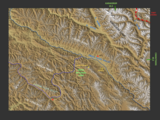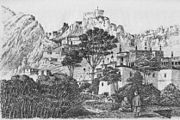Hemis National Park
Hemis National Park
Hemis NP | |
|---|---|
National Park | |
 Stok Kangri peak inside Hemis NP | |
| Country | |
| State | Jammu and Kashmir |
| District | Leh District |
| Established | 1981 |
| Area | |
• Total | 4,400 km2 (1,700 sq mi) |
| Elevation | 3,000 - 6,000 m (−17,000 ft) |
| Languages | |
| • Official | Urdu |
| Time zone | UTC+5:30 (IST) |
| Nearest city | Leh |
| IUCN category | II |
| Governing body | Government of India, Government of Jammu and Kashmir, Ladakh Autonomous Hill Development Council |
| Precipitation | 160.5 millimetres (6.32 in) |
| Avg. summer temperature | 15 °C (59 °F) |
| Avg. winter temperature | −30 °C (−22 °F) |
Hemis National Park (or Hemis High Altitude National Park) is a high altitude national park in the eastern Ladakh region of the state of Jammu and Kashmir in India. World famous for being the best place to see the snow leopard in the wild, it is believed to have the highest density of snow leopards of any protected area in the world.[1] It is the only national park in India north of the Himalayas, the largest notified protected area in India (and thus the largest national park of India), and is the second largest contiguous protected area after the Nanda Devi Biosphere Reserve and surrounding protected areas. The park is home to a number of species of endangered mammals including the snow leopard. Hemis National Park is India's only protected area inside the Palearctic ecozone, outside the Changthang Wildlife Sanctuary northeast of Hemis, and the proposed Tso Lhamo Cold Desert Conservation Area in North Sikkim.
The park is bounded on the north by the banks of the Indus River, and includes the cachements of Markha, Sumdah and Rumbak, and parts of the Zanskar Range.
History
The park was founded in 1981 by protecting the Rumbak and Markha catchments, an area of about 600 km2 (230 sq mi). It grew in 1988 to around 3,350 km2 (1,290 sq mi), by incorporating neighboring lands.[2] It increased again in 1990 to 4,400 km2 (1,700 sq mi),[3] and is the largest national park in South Asia.
Human history
The park houses numerous Tibetan gompas and holy chortens within its boundaries. These include the famous 400-year-old Hemis Monastery. Hemis was a destination and via point on the silk routes of Tibet. Over 1,600 people live inside the park presently, with a large number of tourists and pilgrims visiting during the Hemis Tsechu festival.
Natural history
The park lies within the Karakoram-West Tibetan Plateau alpine steppe ecoregion, and contains pine forests, alpine shrublands and meadows, and alpine tundra.
Fauna

The park is home to a viable breeding population of about 200 snow leopards, especially in the Rumbak catchment area. The prey base for the apex predator in the Central Asian Highlands is primarily supported in Hemis by Argali (Great Tibetan Sheep), Bharal (Blue Sheep), Shapu (Ladakhi Urial), and livestock. A small population of the Asiatic Ibex is also present in Hemis. Hemis is the only refuge in India containing the Shapu.[4]
The Tibetan wolf, the Eurasian brown bear (endangered in India), and the red fox are also present in Hemis.[5]
Small mammals include the Himalayan marmot, mountain weasel and the Himalayan mouse hare.
The park is a good place to study Himalayan and Trans-Himalayan birds of prey. Among birds of prey noted here are the golden eagle, the lammergeier vulture, and the Himalayan griffon vulture.
The Rumbak Valley offers good opportunities for birdwatching, including several Tibetan species not common in other parts of India. Birds present here include brown accentor, robin accentor, Tickell's leaf warbler, streaked rosefinch, Tibetan snowfinch, chukar, fork-tailed swift, red-billed chough, Himalayan snowcock, and the fire-fronted serin.
16 mammal species and 73 bird species have been recorded in the park so far.
Flora [6]
This region is in the rain shadow of the Himalayas, and does not receive much precipitation. Hence, dry forests of juniper, Populus - Salix forests, subalpine dry birch - fir are present at lower altitudes. You will find alpine and steppe trees predominantly at Hemis High National Park. These trees and shrubs are spread across the valley bottoms. Since the upper mountain slopes are moist, this area is characterized by alpine vegetation including: Anemone,Gentiana, Thallctrwn, Lloydia, Veronica, Delphinum, Care.x and Kobresia. The other parts of the park support steppe vegetation which is dominated by Caragana, Artemisia, Stachys, and Ephedra, present along the lower river courses. A study conducted by CP Kala reports 15 rare and endangered medicinal plants growing in the Hemis National Park, which include Acantholimon lycopodiodes, Arnebia euchroma, Artimisia maritima, Bergenia stracheyi, Ephedra gerardiana, Ferula jaeschkeana, and Hyoscyamus niger.[7]
Over 1,600 people live inside the park boundaries, mostly pastoralists raising poultry, goats, and sheep. This results in considerable animal-human conflict within the region. Snow leopards prey on livestock, sometimes killing several animals from a single flock in one hunt. This has been attributed to the overgrazing of livestock. Crop damage caused by bharal has also been seen.
The Department of Wildlife Protection, Government of Jammu and Kashmir is the custodian of the Hemis National Park. Any activity in the park is prohibited unless special permission is obtained from the Chief Wildlife Warden J&K. The department has initiated many projects for biodiversity conservation and rural livelihood improvement in Ladakh, including the Hemis National Park, such as
- Project Snow Leopard for Conserving the entire Himalayan biosphere. The project was initiated by the department in 2004 and was formally launched on 20 February 2009.
- Ladakh Eco tourism Project
- Ladakh Homestays: A program for providing tourists with access to homestays in local villagers' residences (source of additional income).
- Nature Guide Training for the educated unemployed youth.
- Eco Cafe for the women Help Group to run the cafe and sell the local handicraft products to the tourist.
- Creation of a no-grazing zone for domestic livestock
- Predator-proofing livestock pens in the area
Tourist activities in the park
No metalled or motorable roads traverse the park. The park offers a number of routes for trekking from mid-June to mid-October. The best season for spotting snow leopards, is, however, in late winter. The historic Hemis Monastery is home to the Hemis Festival (Hemis Tsechu) every summer. Lodging is restricted to backcountry camps, villager homestays and accommodation at the monasteries.
Approach
- Nearest airport: Leh Kushok Bakula Rimpochee Airport, Leh district about 5 km away
- Nearest railhead: Kalka, Haryana
- Nearest highway: Leh-Manali Highway, and National Highway 1D (Srinagar - Kargil - Leh), both near the northern borders of the park
- Nearest town: There are quite a few villages, and gumphas (monasteries) inside the national park
- Nearest city: The city of Leh is 10 km to the north of the park.
In popular culture and religion
The 400-year-old Hemis Monastery has long been a place of pilgrimage for Tibetan Buddhists. However, in the late 19th and early 20th century, the monastery attracted some attention due to the writings of Nicolas Notovitch, a Russian aristocrat and journalist, who claimed that Jesus had spent the missing years of his life in Tibet and Ladakh, specifically in Hemis. (see Lost years of Jesus)
The national park, monastery and the Changthang Wildlife Sanctuary were prominently featured in the award-winning documentary Riding Solo to the Top of the World.
Gallery
- Hemis NP
-
A terrain map of Hemis National Park and the surrounding trans-Himalayan Ranges
-
Courtyard of the historic Hemis Monastery inside the NP
-
Hemis monastery in the 1870s
-
Confluence of the Zanskar River into the Indus River at the border of the park
-
Stok Kangri, the highest peak inside the park boundaries
See also
References
- ^ http://www.cloudbirders.com/tripreport/repository/BARUAH_India_03_2014.pdf
- ^ Encyclopaedic Dictionary of Environment By G R Chhatwal, D K Pandey, K K Nanda Published by Anmol Publications PVT. LTD., 1988 (ISBN 8170411009), (ISBN 9788170411000)
- ^ a b http://www.snowleopardnetwork.org/bibliography/anlp99.htm
- ^ Wild Sheep and Goats and Their Relatives: Status Survey and Conservation Action Plan for Caprinae By David M. Shackleton, International Union for Conservation of Nature and Natural Resources Species Survival Commission. Caprinae Specialist Group Contributor David M. Shackleton Published by IUCN, 1997 (ISBN 2831703530), (ISBN 9782831703534)
- ^ a b Out of the Shadows, National Geographic Magazine, June 2008
- ^ Handbook of National Parks, Wildlife Sanctuaries and Biosphere Reserves in India By S.S. Negi Published by Indus Publishing, 2002 (ISBN 8173871280), (ISBN 9788173871283)
- ^ Kala, CP 2005. Indigenous Uses, Population Density, and Conservation of Threatened Medicinal Plants in Protected Areas of the Indian Himalayas. Conservation Biology, 19 (2): 368-378 http://onlinelibrary.wiley.com/doi/10.1111/j.1523-1739.2005.00602.x/abstract
Bibliography
- Management Plan Hemis High Altitude National Park, Jigmet Takpa IFS and Saleem Ul Haq.
- Hemis High Altitude National Park-Government of Jammu and Kashmir, Department of Wildlife Protection, Wildlife Division(LAHDC) Leh-Ladakh
- Chettri, Nakul. 2003.
- Ladakh: The Land and the People, By Prem Singh Jina. Published by Indus Publishing, 1996 (ISBN 8173870578), (ISBN 9788173870576)





